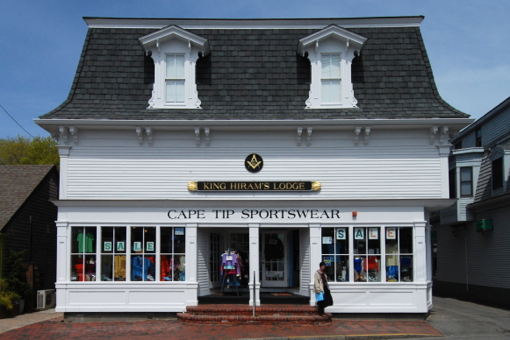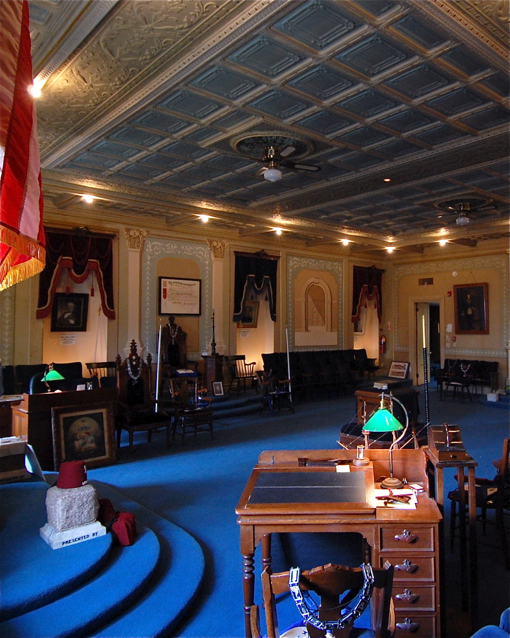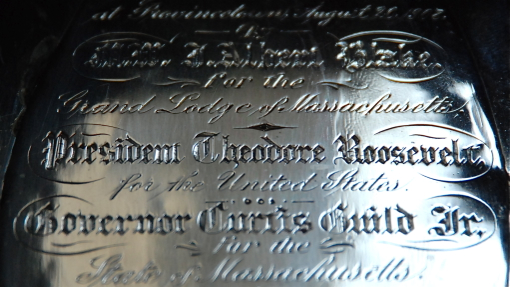PROVINCETOWN — It is not meant to be a secret that the world’s most ubiquitous secret society — or rather “society of secrets,” as described to the Independent by one member — has a home in the heart of Provincetown.

Emblazoned proudly above Cape Tip Sportswear on Commercial Street is a black-and-gold insignia composed of a square, a compass, and the letter “G,” which stands for both God and geometry. Below that is a placard that reads “King Hiram’s Lodge,” alerting passersby who happen to look up that the building at 2 Masonic Place is home to the Provincetown chapter of the Ancient Free and Accepted Masons.
Chartered on Dec. 12, 1795, by Paul Revere, the organization’s Grand Master of Massachusetts at the time — the same Paul Revere who, employed as an express rider by the Boston Committee of Correspondence and the Massachusetts Committee of Safety, alerted the rebels that the British were coming — King Hiram’s Lodge is the oldest continuously operating institution in Provincetown.
It is a fraternal order with roots that run deeper than Boy Beach or the Macho Room in the next-door Atlantic House.
The history of King Hiram’s Lodge is a history of Provincetown, member Ralph Desmond said, showing a reporter for the Independent around the lodge. Inside the lodge room, with walls covered in trompe-l’oeil murals by Carl Wendte, the German artist who also painted the sanctuary of the Unitarian church in the 1870s, perfectly preserved ephemera hang behind frames and sit inside locked glass cabinets. Together, they tell the story of this seaside chapter of a social organization dating back to Europe’s stonemasons of the Middle Ages.

One wall displays the charter signed by Revere in 1795. Back then, a group made up of 22 members met at Jonathan Cook’s home at 292 Commercial St. At the lodge’s first meeting on Dec. 20, 1796, it was decided that members were to meet on the first Monday of every month.
“If it is a storm, the next fair night,” that meeting’s minutes read, according to James Theriault’s 1996 book Every First Monday: A History of King Hiram’s Lodge, Provincetown, and Its Members.
“We haven’t missed a regular meeting since then,” current member Myles McKay of South Harwich told the Independent. “Storms, hurricanes, or blizzards, we always meet. Except in July and August — it’s too hot, and there is no place to park.”
The original Provincetown Masons, being masons as it were, wasted no time in building the lodge’s first home in the winter of 1797. According to Theriault, the structure was put up within a month, and the builders were paid in rum and brandy. The house still stands as a private residence at 119 Bradford St.
But masons at the time mostly found work in the burgeoning whaling industry. Those employed in occupations tied to the sea outnumbered the practitioners of any other profession in the history of King Hiram’s Lodge, according to Theriault. Whether members were mariners, sail makers, boat builders, caulkers, or fishermen, such occupations are mentioned 422 times in the lodge’s membership roll, which is housed within the lodge’s walls.
Members of King Hiram’s Lodge today include fewer builders, said Ralph Desmond. The work of the modern-day Provincetown Masons is more speculative in nature, meaning, “we like to make good men better — better men, better husbands, better neighbors, better citizens,” Desmond said.
“Bad men go to the tavern. Good men go to the lodge,” he said. “And then the tavern.”

To be a Mason in Massachusetts, one must be male, at least 18 years of age, and believe in God, Desmond said. Belief is required because new members must take an oath on a sacred text. Desmond said that the lodge houses the Old Testament, the New Testament, the Quran, and the Veda, but “I always say if you believe in butter and sugar, you can take it on the Fannie Farmer Cookbook.”
There are around 145 members of the lodge these days, with roughly a quarter of them attending any given meeting. The current Master Mason of King Hiram’s Lodge, Howard Hernandez, has been missed lately. He is also a major in the U.S. Army, serving as a psychiatrist on active duty in Texas right now.
Among Masonry’s ancient rituals, a hierarchy of sorts contains three distinctions conferred upon members of any given lodge. Entered apprentices are lowest in the ranking. Once a candidate demonstrates his knowledge of the degree, he moves on to become Fellow Craft, and then Master Mason, who leads the lodge for a term of one to two years, voted on democratically by other members.
The many secrets of Masonic ritual are no longer secret, Desmond said. The handshakes and passwords, which were once used to determine a worker’s wage based on his Masonic ranking, “are all out on the web now. You can find those.” The real secrets, Desmond disclosed, are “brotherly love, relief, and truth.”
Masons weren’t always so cavalier about their secrets, however. The darkest moment in Masonic history, known as the “Morgan Affair,” took place in 1826 in Batavia, N.Y., when a self-proclaimed Mason named William Morgan threatened to publish an exposé of the secret rituals of masonry in the Republican Advocate, a local weekly newspaper.
Following Morgan’s subsequent mysterious disappearance and the pointing of fingers at a local group of Masons, public outrage erupted across the country, leading to the closure of many lodges and the formation in 1828 of the Anti-Masonic Party, America’s first third party.
During the anti-Masonic movement, membership in Massachusetts lodges dwindled. The number of lodges across the state plummeted from 101 to 24 within six years; there are no records of King Hiram’s Lodge meetings from 1832 to 1834, and only a handful until 1840, according to Every First Monday.
According to the minutes from the March 1840 meeting, members of the lodge were directed by the Grand Lodge of Massachusetts to “collect all dues and get their returns or they must [relinquish] their Charter and Regalia to the Grand Lodge.” Members voted to sustain the lodge and not return the charter.
On Jan. 7, 1870, the lodge had its first meeting at its present location on the corner of Commercial Street and Masonic Place. The place was built with three floors that, back then, towered over the surrounding buildings.
The first floor housed two shops to provide income to the lodge. On the second floor, a giant banquet hall became the epicenter of Provincetown social life during the winter. Plays, musical entertainment, readings, and dances all took place in the hall. In Time and the Town, Mary Heaton Vorse described the get-togethers as “among the gayest and pleasantest of all the dances.”
The banquet hall also hosted the annual town meeting in 1877, after the original town hall on High Pole Hill burned down. The warrant for that meeting can be found in the lodge’s collection.
The banquet hall fell into disrepair in the 20th century. In 1971, the lodge suffered structural damage, resulting in a new foundation being installed. The first floor was removed, and the entire building was lowered. Cape Tip Sportswear is now housed within the walls where the dances were held.
Perhaps the lodge’s proudest possession sits encased in glass beside the grand master’s seat in the meeting room. A trowel engraved with President Theodore Roosevelt’s name commemorates the central role King Hiram’s Lodge played in the dedication of the Pilgrim Monument on Aug. 20, 1907.
On that date, President Roosevelt arrived in Provincetown by boat, and behind him trailed eight battleships. “When they fired their guns, they broke windows in Wellfleet,” Desmond said. With the help of Grand Master of Massachusetts M.W.J. Albert Blake, and assisted by nearly 100 lodge members, Roosevelt performed the Masonic ritual of laying the cornerstone of the monument.
In his speech, Blake said: “From time immemorial it has been the custom of the Ancient and Honorable Fraternity of Free and Accepted Masons, when requested so to do, to lay, with ancient forms, the corner stones of buildings for the worship of God, for charitable or educational objects, and for the purposes of the administration of justice and free government.”
But while the many artifacts housed at King Hiram’s Lodge — the trowel inscribed with Roosevelt’s name, the 1877 town meeting warrant, the membership rolls, and the original charter signed by Paul Revere — all tell a treasured history of the lodge, “the real treasure is the brothers who came before, the brothers who are here now, and the brothers who will come later,” Desmond said.
McKay said that throughout the quickly changing tides of Provincetown history, King Hiram’s Lodge has remained a stable force in town. “In the middle of winter in Provincetown,” he said, “if you can still get 30 guys together all dressed up, that’s pretty impressive.”
